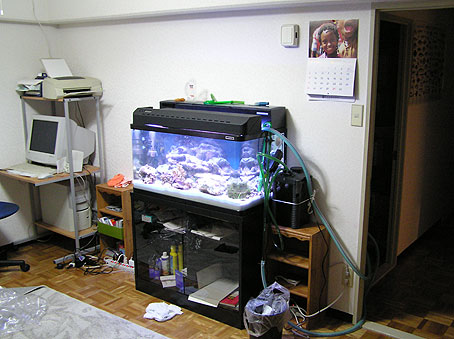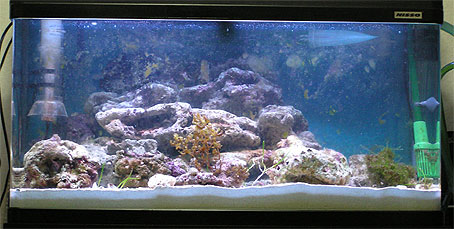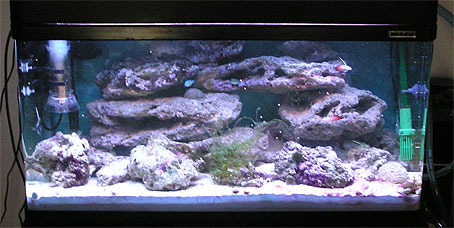Setting up the system
I started setting up my first fish tank in late March, 2004. This page describes how I set the system up, and was written before I got my second tank.
|
The first point of order was a discussion with my wife Keiko as to how big it should be, with me wanting to fill as much space in the living room as possible! Eventually we compromised on a 90 x 45 x 45 cm tank. Naturally, bigger is better, but there is only so much space in a small Japanese aprtment.
We didn't want to expend too much effort in getting the hardware together, so this meant limiting ourselves to commercially available components. This essentially meant a sumpless system, since these are not very easy to find in Japan, and we were reliant on borowing a car to do our shopping. Even a 165 litre tank is considered large here!
The tank is in the living room-cum-dining room-cum kitchen, which has a very odd design in that it has no windows, so it, and therefore the tank, has to be entirely artificially lit. After putting together the stand - just a standard glass-doored cabinet, the sea-water mix (Sealife Marine Tech) was added. I have no idea how this salt mix matches up compared to others in terms of composition, because my Japanese is completely inadequate to the task!; in any case, it is all the LFS (local fish shop) had. The substrate - essentially standard quartz sand, with an average particle diameter of under 1 mm - was then added; it averages about 5 cm deep which is enough to provide a rudimentary benthic habitat. You can only have so much in a 45 cm deep tank!
|

|
|
Two smallish pieces of live rock, totalling about 3 kg, were added the next week to help start the cycling, and after a few more days, a few crystals of ammonium chloride were added just in case the live rack wasn't as live as advertised! Over the next two weeks, some more commercial live rock was added, to make 5 smallish pieces in total, a small (10 litre) water change was done, the lights were started up (two 32 W flourescents at this stage, one blue, the other white, both from 11 AM to 11 PM). Ammonium levels were undetectable at this stage; indeed I have never detected ammonium/ammonia in this system with the Tetra test kit I use.
The set-up has both an overhead upper filter ring/chip system for bacterial cultivation, as well as more rings/chips in the main pump (an Eheim 2224 unit, 700 l/hr). Overhead systems appear to be fairly common in Japan, they have a big disadvantage IMO in that they take up too much valuable space that could be otherwise used for overhaed lighting. The next system I set up will have a proper sump so this can be done away with...
|

|
A 'benthos' pack from an on-line shop in Ishigaki-jima (a Japanese island close to Taiwan) was added to give the substrate some life; this included a few hermit crabs that are still around; we also added some 3 gold ringed cowries (Cypraea annulus), or hanabira takaragai in Japanese (petalled treasure-shell), and several snails of some species of the Trochidae genus, called nishikiuzugai in Japanese (brocaded/coloured spiral-shell) to cut back the inevitable brown algal bloom; again, these are from Ishigaki-jima.
|
On 12/4/2004, two weeks into the set-up, the bulk of the live-rock was added. This was collected from near Kushimoto, at the very south of Wakayama prefecture, and includes several large (30 cm long) pieces, some with quite big caverns and warrens. Some Wakayama-sea water was added at this time too. On 15/4/2004 I rearranged the rock, to ensure a better water circulation pattern around the bottom of the tank; by 18/4/2004 as a consequence of the mass of added bio-matter with the live rock, nitrite levels had risen to 0.4 mg/l and the system was obviously well into a major cycling event. As you can see from the pictue to the right; there isn't much in the way of gaps between, and especially under, the rocks.
|

|
By 9/5/2004, pH was getting low, down to 7.9 (the snails were happily multiplying), so calcium hydroxide was added to move it up to 8.4; on this day the first fish were added, 7 weeks after the first water was added to the tank, three Green chromis (Chromis viridis, debasuzume in Japanese) and a Blue-cheeked goby/Yellow-headed sleeper goby (Valenciennea strigata, or akahachihaze in Japanese). The last was added to sift the substrate; it would of course eat the things living in it too, but I calculate it can't possibly sift every spot in the substrate (directly under the main rocks, for instance). It does tend to scatter sand over every surface less than 15 cm up however, which makes for quite a maintenace problem if I want the smaller live rock pieces to remain looking attractive! Compared to the previous photo, the picture below, of how the system looked at the end of May 2004, shows a much better set-up in terms of rock position.
|
By mid-May nitrite levels had started to fall; below 0.3 mg/l, another small water change was done, and two weeks later, two Fire dartfish/Fire dart gobies/Red firefish (Nemateleotris magnifica, hatatatehaze in Japanese) were added, primary cycling having been judged complete. One of the chromis had died a week before, of unknown causes, but this was the only apparent casualty apart from several hitch-hiking crabs that came in the Wakayama live rock. Since one of the commercial live rock pieces seems to have contained a mantis shrimp, this my be have been the cause. I had once spotted a red and white invertebrate hiding in a hole who may have the villain; traps laid out for it failed to entice it out however. It's only small though, so shouldn't pose too much of a problem (I suspect it had nothing to do with the death of the Chromis; it showed no obvious injuries), and I haven't heard it recently, so it may have 'solved itself'!
|

|
Post-script added 10th July: the mantis shrimp may have been a problem after all, since the goby simply disappeared one day; however my conclusion that cycling may have been complete may have also been wrong, since one of the firefish died too.
This page created 29 May 2004 and last modified 10 July 2204.
Return to my fish tank main page.